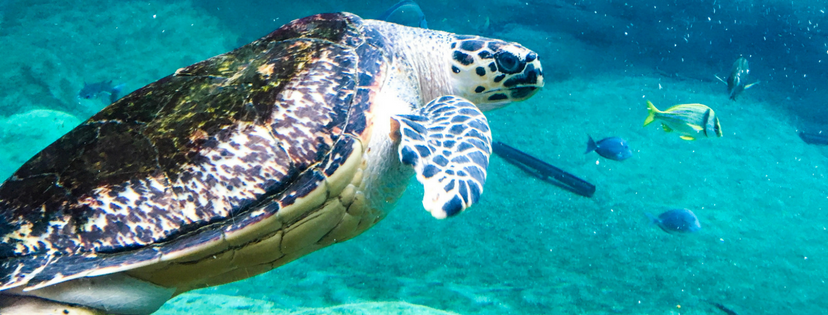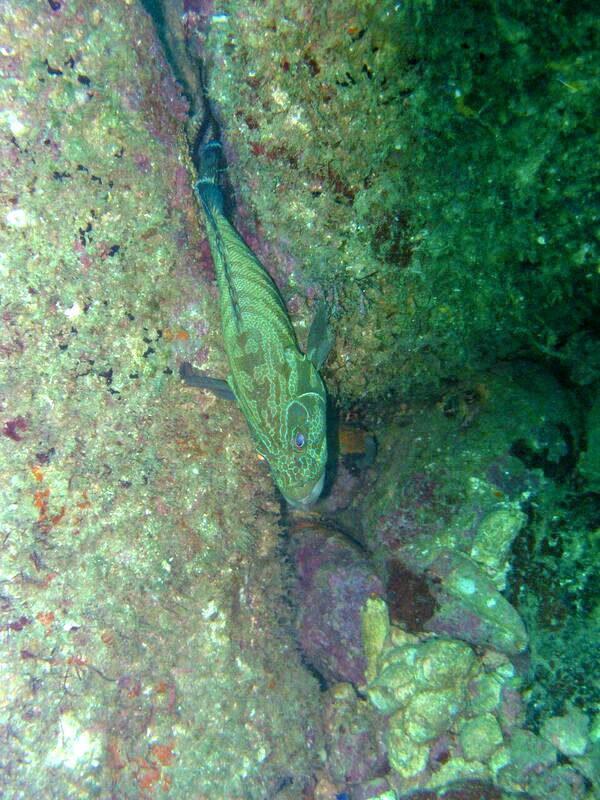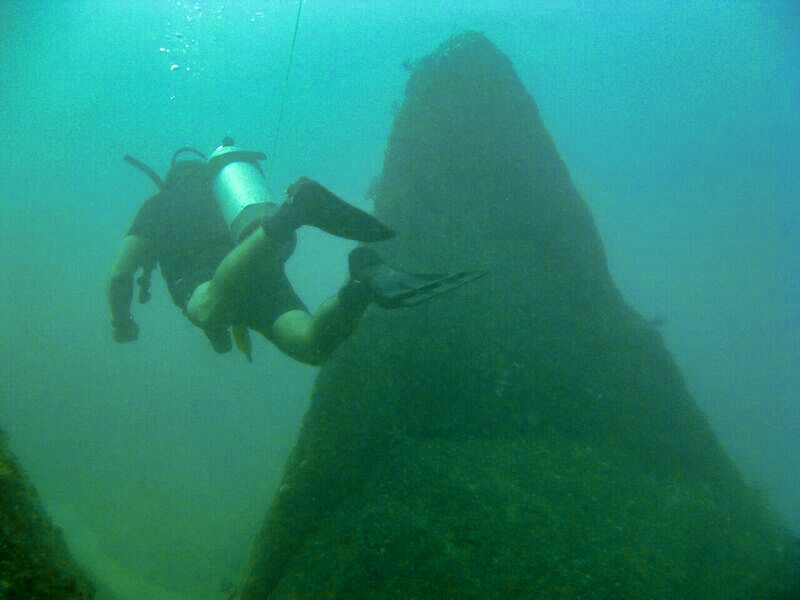Last Updated on December 30, 2023 by Natalie
I always want to do all of the “swim with marine creatures” activities that are available. Swimming with dolphins has long been on my wish list. Swimming with dolphins, turtles, or stingrays sound so alluring. Are they good for the creatures in question? Here is how to have ethical animal encounters in the Caribbean AND my handy-dandy guide to some of the most popular attractions.
Best practices to have ethical animal encounters in the Caribbean
First here are a few steps to ensure you are having a ethical animal encounters with marine creatures in the Caribbean. Around the world, if an activity seems too good to be true (tame tigers come to mind), it probably isn’t true. If you can’t get straight answers from the vendor about the activity or if something seems “off” about it, there is probably something going on that is objectionable.
I haven’t always been proactive with researching attractions before attending them. Always, I hope to do better in the future and help others to do so as well.
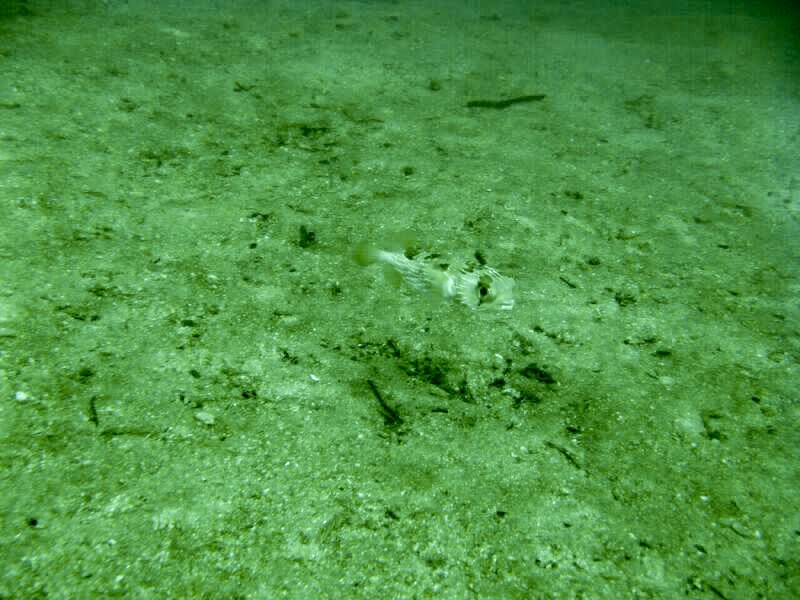
Disclaimer
This post contains affiliate links. If you click them and make a purchase, I’ll receive a small commission at no additional cost to you. These payments help reduce costs of running this site. I appreciate you visiting today!
Things to Do
- Research whether or not the item you want to do is ethical, free from abuse, and not harmful for the creatures in question
- Look for tour operators who DON’T feed the wild life to attract them
- Research how to act and what to expect around the creatures you’ll be encountering (both for their safety and yours)
Things not to do
- Don’t touch the wildlife
- Don’t walk on the coral. It’s alive and walking on it can kill it
- Do not kiss the wildlife
- Don’t take selfies or pictures while holding or if someone else is holding the wildlife
- Do not chase or corner the marine animals and fish
Guide to Popular Animal Tourist Attractions in the Caribbean
Since I want to go everywhere and try so many different activities, I’ve researched the most popular tourist attractions involving animals in popular tourist areas. I’ve included whether or not I’ll be frequenting these attractions. As usual, I’ll leave the ethical decisions up to you and your personal code.
Marinarium in Punta Cana, Dominican Republic
Looking at their website, they sound like a great company. They talk “the talk” about ecotourism. Their website claims they are recognized as “an international class eco-tourism excursion,” but reviews tell a different story of the same-old same-old when it comes to the marine creatures in its care. In their tours, they advertise swimming with sharks and rays. It turns out those animals are caged and unable to escape the hordes of tourists they see on a daily basis. While I believe they advise that tourists shouldn’t touch the nurse sharks, they do offer photo opportunities while holding the stingrays.
I give this attraction/company a hard no.
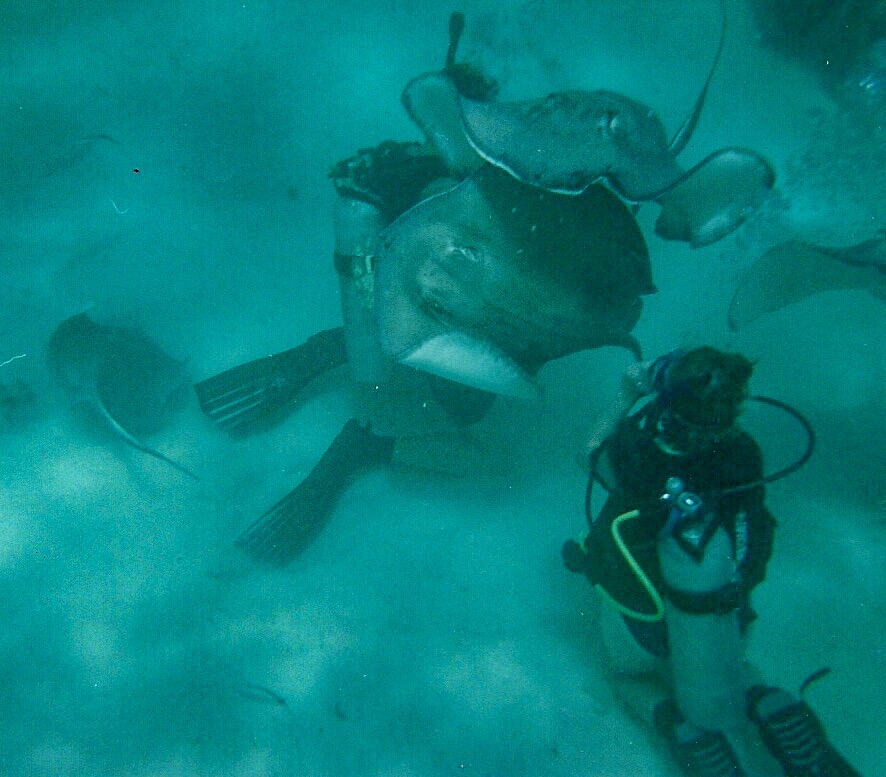
Diving in Stingray City.
Stingray City in Grand Cayman
I went diving at Stingray City many years ago and while it was overall a wonderful experience for me, I’ve realized in hindsight that it wasn’t an ethically sound decision. The only plus is that on my tour, we didn’t take selfies with or kiss the rays. The rays, however, weren’t shy about kissing me!
The attraction has grown and because the rays are fed, there are a large number of rays in the area. They are fed squid by the tourists/tour operators, which isn’t part of their normal diet. The area is getting depleted of their normal types of food and the stingrays there are pretty sedentary. Typically, rays hunt at night, alone, and cover a lot of ground. The rays at Stingray City, while not caged, show much less movement.
Additionally, there have been concerns raised whether or not the sun is damaging their skin. Normally, they would spend their days mostly buried in the sand, except the tourists come during the day. Since the stingrays are active during the day now, effects from the sun, such as skin cancer are a valid concern.
If you can find an operator who doesn’t feed or touch the rays, it may not be an ethical conundrum for you. This is an activity I will not repeat.
Grand Cayman Turtle Farm on Grand Cayman Island
Reading about the conditions in the Grand Cayman Turtle Farm is appalling. Even without the accusations of crowded conditions and selling the meat of endangered turtles, they do offer photos and swimming with turtles options. I will not be supporting this attraction at this time. I’m also thankful I didn’t unknowingly visit during my trip to Grand Cayman several years ago.
Shark Ray Alley in Belize
Shark Ray Alley (I’ve also seen it called Shark Alley) is a spot similar to Stingray City in Grand Cayman. It was a shallow area where fishing boats cleaned up after their daily catch and it attracted sharks and stingrays. Snorkeling tours to this spot are available daily.
Just like with Stingray City in Grand Cayman, this presents an ethical dilemma. Often, tour operators will feed the animals. Some of the problems with this include the population of creatures in that area being too dense, leading to fights between individuals for food and space. It contributes to more injuries and diseases spreading faster between the fish (this is true for the rays in Grand Cayman, it’s also likely to impact the rays and sharks in Shark Ray Alley).
If you are hellbent on doing this type of tour, look for a company that does not feed or touch the marine life. This compromise is probably not enough for me to go see Shark Ray Alley. I will choose to snorkel in a different place when we finally visit Belize.
For some better dive options, check out the best dives in Belize.
Swimming with Pigs in Bahamas
It sounds like a pig paradise! In fact, ever since I’ve heard about it, visiting Pig Beach has been on my wish list. However, I have a few concerns. While the pigs “roam free,” pigs do have sun sensitive skin. Since they live on a sandy beach, they do not have mud to roll in for protection. They also do not have any form of sturdy shelter. Pigs are subjected to the hot Caribbean sun all day long and therefore have a higher risk of getting skin cancer. It’s likely if they get skin cancer, they will suffer for awhile without vet care before dying.
There is danger to tourists, as well. These pigs aren’t exactly feral and they aren’t exactly tame. I’ve read accounts where people were bitten when they turned their back while holding food.
This is an attraction that could be fixed to provide for the animals. A lot of tourism dollars come in from people going to see the pigs and those dollars could provide solid shelter, regular food, and veterinary care. If such a company is working towards providing these services, I’d support that company without an ethical problem. Until then, I will avoid this attraction.
Swimming with dolphins – Worldwide
From the first time I saw people swimming with dolphins, I have wanted to participate. Once I started researching it, I realized quickly that my dream will never be realized. Dolphins in captivity are kept in horrible conditions and are typically underfed so that they will perform for tourists. In addition, dolphins are captured and transported in horrendous ways. They suffer when separated from their pod and captive dolphins have significantly shorter life spans. Many dolphins die during capture and transit.
Alternatively, swimming with dolphins in the wild can also affect a pod by pushing them away from their normal restful places due to too many boats and tourists. Furthermore, people have been injured and harassed by dolphins and it really isn’t in anyone’s best interest (human or dolphin). As I was researching this post, I happened to see a video where a dolphin was harassing a girl. When she wet to the guy swimming with her for help to avoid the dolphin, the dolphin harassed both. I doubt those swimmers enjoyed their experience. Certainly, the dolphin wasn’t happy, either.
I will not be participating in swimming with dolphins, even in the wild, unless it happens completely by accident.
Look for businesses with the Dolphin Smart Seal.
Where is the Best Place to Swim with Dolphins?
There isn’t one. Even dolphin excursions, like swimming with wild dolphins, aren’t good for the creatures. As mentioned above, dolphins in captivity have significantly shorter lifespans than their wild peers. Often, the methods to capture dolphins from the wild are inhumane and many dolphins die in transit. Since they are often kept in shallow enclosures, their skin also suffers from too much sun.
Additionally, the forced routine of captivity can make dolphins act “badly” (wouldn’t you?) and could cause injuries to humans.
Please, please don’t spend your tourist dollars on this activity, anywhere in the world.
Swimming with Whale Sharks in Cancun or Holbox Island, Mexico
Information on the negative side of this is limited. Swimmers and divers do need to be very careful around these amazingly large creatures because the whale sharks can and do drop without warning, trapping you underneath.
In Mexico, they don’t feed the whale sharks, so this is limited to seasonal availability. Regular sunscreen can damage whale shark skin, therefore an ethical company will make sure no one is wearing any (natural sunscreens are okay). Also, tours seem to be limited to three people at a time, two guests and one guide, in an effort to not spook the whale shark(s).
Without further damaging information, I’m cautiously optimistic that swimming with the whale sharks is a sustainable and humane creature encounter. I plan to keep researching this and do it if nothing seems inhumane or unsustainable.
Swimming with Sea Lions – La Paz, Mexico
This is another activity I really want to do. So far, it seems that tour operators are mostly respectful and follow the dos and don’ts I’ve listed above. There is definitely a risk to the snorkelers, since alpha male sea lions can be dangerous. As long as you carry travel insurance and follow directions, it seems like another humane attraction.
Snorkeling and Diving – Worldwide
I’m a certified scuba diver. During my certification classes, it was drilled into us to respect marine life. Don’t touch the fish or coral. Always be respectful of the ocean. I do believe that diving and snorkeling are ethically sound activities for tourists to participate in if they follow these same rules. Never, ever touch sea life. Do not feed the creatures you encounter. If you respectfully observe all the interesting life around you, you will come out of the water with satisfaction and not sadness. You will see ocean life acting normally and in it’s normal habitat.
Do you agree or disagree with my observations? Tell me why! Have you ever participated in an animal activity and regretted it? How do you have ethical animal encounters in the Caribbean?
Book your trip responsibly and ethically with Intrepid Travel!

